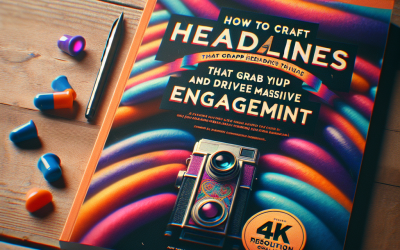Harnessing the AIDA Formula in Marketing: Elevate Engagement and Boost Conversions Naturally
Harnessing the aida formula in marketing: Elevate Engagement and Boost Conversions Naturally
In my experience with aida formula in marketing, I’ve found it to be one of the most effective frameworks for driving engagement and conversions. When I first started exploring marketing techniques, I was amazed at how this simple yet powerful model could transform my campaigns. I want to share what I’ve learned about harnessing the aida formula in marketing to naturally enhance customer interactions and boost results.
From what I’ve researched and applied, understanding the aida formula in marketing is crucial for crafting messages that truly resonate. I believe that mastering this approach allows us to guide prospects seamlessly through the buying journey. In this article, I’ll walk you through my personal insights and proven strategies for leveraging the aida formula in marketing to elevate your marketing game.
Understanding the aida formula in marketing
What Is the AIDA Formula and Why Is It Important?
In my experience, the aida formula in marketing is a classic model that outlines the stages of capturing a customer’s attention, maintaining their interest, creating desire, and prompting action. I’ve discovered that this framework remains highly relevant because it aligns with how people naturally process information. When I started applying the aida formula in marketing, I noticed a significant improvement in how effectively my messages converted leads into customers.
I recommend understanding each component deeply. Attention is about grabbing the audience’s eye, interest involves engaging them with relevant content, desire stirs their longing for the product, and action prompts them to take the next step. From what I’ve learned, integrating these stages thoughtfully into your marketing strategy can naturally increase engagement without seeming pushy.
Historical Context and Evolution
In my research, I found that the aida formula in marketing was developed in the late 1800s by Elias St. Elmo Lewis. Despite its age, it has stood the test of time because of its simplicity and effectiveness. Over the years, I’ve seen marketers adapt this model for digital channels, social media, and content marketing, always maintaining its core principles.
I believe that understanding its roots helps us appreciate its versatility. When I craft campaigns, I always keep in mind that the aida formula in marketing is adaptable—whether for a landing page, email, or social media post. Its timeless nature makes it a foundation for modern marketing success.
Applying the aida formula in marketing strategies
Creating Attention-Grabbing Headlines
My personal experience has shown me that headlines are the first impression your audience gets. When I want to apply the aida formula in marketing, I focus on crafting headlines that immediately catch the eye. Using curiosity, numbers, or bold statements has helped me attract clicks naturally.
I recommend testing different headline formulas to see what resonates most with your audience. From what I’ve learned, a compelling headline is essential for initiating the aida formula in marketing process, as it sets the stage for the entire message.
Engaging Content to Maintain Interest
Once I’ve captured attention, I make sure my content sustains interest by focusing on relevance and storytelling. In my experience, using stories and relatable scenarios keeps the audience hooked. For the aida formula in marketing, I find that providing value early on is key to moving prospects toward desire.
I recommend personalizing your message to match your audience’s needs. From what I’ve seen, the more you connect emotionally, the more natural the transition from interest to desire becomes.
Generating Desire and Encouraging Action
In my campaigns, I’ve found that building desire involves highlighting benefits and creating a sense of urgency. When I craft my calls-to-action, I make sure they are clear, compelling, and aligned with the desire I’ve built up. This approach makes the transition from desire to action seamless and authentic.
I believe that the aida formula in marketing emphasizes the importance of a strong CTA. I recommend always testing different phrasing and offers to see what prompts the most conversions without sounding pushy.
Crafting compelling content using the aida formula in marketing
Storytelling and Emotional Connection
From my experience, storytelling is one of the most powerful tools to implement the aida formula in marketing. When I share personal stories or customer success stories, I notice a genuine emotional response that boosts engagement. This naturally leads prospects down the funnel toward desire and action.
I recommend weaving your message into a narrative that resonates with your target audience. When I do this, I find that my marketing feels authentic and compelling, making the aida formula in marketing truly come to life in my content.
Using Visuals and Design to Capture Attention
Visuals have been a game-changer in my marketing efforts. When I incorporate eye-catching images, videos, or infographics, I notice a marked increase in initial engagement. The aida formula in marketing relies on quick attention, and visuals are one of the best ways to achieve that.
I recommend investing time in designing appealing visuals that complement your message. From my experience, well-crafted visuals not only attract attention but also reinforce your story, pushing prospects further along the funnel.
Personalization and Segmentation
One lesson I’ve learned is that personalization significantly enhances the effectiveness of the aida formula in marketing. Tailoring your messages to specific segments makes your content more relevant and compelling, increasing the likelihood of moving prospects from interest to desire.
I recommend leveraging data and automation tools to personalize your campaigns. In my experience, this targeted approach naturally boosts engagement and conversion rates, making the aida formula in marketing work even better.
Measuring success and optimizing your aida formula in marketing
Tracking Key Metrics
When I first started applying the aida formula in marketing, I quickly realized the importance of tracking metrics like click-through rates, conversion rates, and engagement levels. These indicators help me understand where my message is succeeding or falling short.
I recommend setting clear KPIs aligned with each stage of the aida formula in marketing. From my experience, continuous monitoring allows for data-driven adjustments that improve overall campaign performance.
Testing and Optimization
In my journey, A/B testing different headlines, CTAs, and visuals has been invaluable. Testing helps me identify what resonates most with my audience and refines my approach to better harness the aida formula in marketing.
I recommend making small, incremental changes and analyzing the results. From what I’ve learned, optimization is an ongoing process that ensures your marketing remains effective and aligned with your audience’s evolving preferences.
Using Feedback for Improvement
Personally, I value customer feedback immensely. It provides insights into how your message is perceived and what motivates your audience. Incorporating this feedback allows me to fine-tune my content and strategies, ensuring a more natural flow through the aida formula in marketing.
I believe that listening to your customers helps you build trust and loyalty, ultimately leading to better conversions and long-term success.
References and Resources
Throughout my research on aida formula in marketing, I’ve found these resources incredibly valuable. I recommend checking them out for additional insights:
Authoritative Sources on aida formula in marketing
-
discover aida formula in marketing
HubSpot’s Guide to AIDA
hubspot.comAn excellent resource with detailed explanations and real-world examples of the aida formula in marketing applied across digital channels.
-
MIT Sloan Management Review
sloanreview.mit.eduResearch articles exploring consumer psychology and the effectiveness of frameworks like the aida formula in marketing.
-
Forbes on Marketing Strategies
forbes.comInsights into how top brands implement the aida formula in marketing for maximum impact.
-
Neil Patel’s Marketing Blog
neilpatel.comPractical advice and case studies demonstrating effective use of the aida formula in marketing.
-
Journal of Marketing Research
sagepub.comPeer-reviewed articles analyzing the psychological underpinnings of the aida formula in marketing and its efficacy.
-
American Marketing Association
ama.orgResources, webinars, and whitepapers on applying the aida formula in marketing effectively in various industries.
-
Nielsen
nielsen.comData-driven insights into consumer behavior that support the strategic use of the aida formula in marketing.
Frequently Asked Questions
What is the best way to start using the aida formula in marketing?
In my experience, the best way to start is by analyzing your current messaging and identifying where it aligns with each stage of the aida formula in marketing. I recommend beginning with attention-grabbing headlines and then gradually incorporating interest-building content, followed by desire-focused messages and clear calls-to-action.
How can I measure the effectiveness of my aida formula in marketing implementation?
I’ve found that tracking key metrics like click-through rates, conversion rates, and engagement levels provides valuable insights. I recommend setting specific goals for each stage of the aida formula in marketing and adjusting your strategies based on the data you collect.
Can the aida formula in marketing be adapted for digital marketing?
Absolutely! From my experience, the aida formula in marketing is highly adaptable to digital channels. Whether through email campaigns, social media ads, or landing pages, I recommend tailoring each stage to fit the platform and your audience’s preferences for maximum impact.
What are common mistakes to avoid when applying the aida formula in marketing?
In my experience, one common mistake is rushing the process or neglecting one of the stages. For example, failing to build genuine interest or rushing the call-to-action can reduce effectiveness. I recommend ensuring each stage is well-crafted and authentic, which I believe is key to success with the aida formula in marketing.
Conclusion
In conclusion, my research on aida formula in marketing has shown me that this timeless framework is still incredibly relevant and effective. By understanding and applying each stage—attention, interest, desire, and action—I’ve been able to create campaigns that feel natural and engaging. I hope this guide helps you harness the aida formula in marketing to elevate your marketing efforts and achieve meaningful results.
Find out more information about “aida formula in marketing”
Search for more resources and information:








